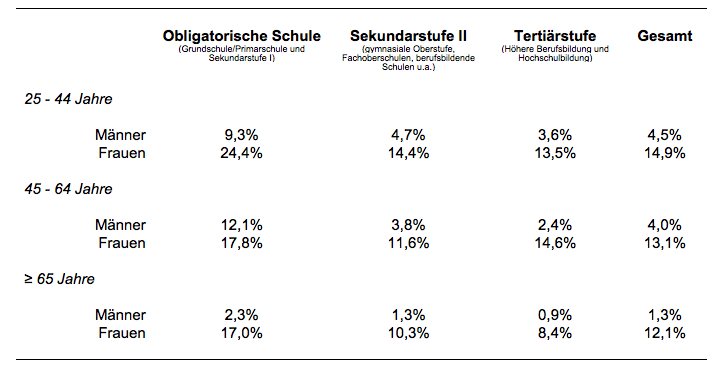Psychische Störungen
Nicole Steck, Thomas Müller
Die psychische Gesundheit ist integraler Bestandteil der WHO-Definition von Gesundheit. Die Weltgesundheitsorganisation schätzt, dass psychische Störungen im Jahr 2015 rund 14% der weltweiten Krankheitslast (Burden of Disease) ausmachten. In Europa beträgt der Anteil der psychischen Störungen an den verlorenen gesunden Lebensjahren gar rund ein Fünftel. Mit dem Mental Health Action Plan 2013-2020 will die WHO die Grundlagen für bessere politische, finanzielle und versorgungstechnische Entscheidungen im Hinblick auf die psychische Gesundheit der Menschen legen. Dies soll u.a. über mehr Mitwirkung der Betroffenen geschehen.
Es gibt eine große Bandbreite an psychischen Erkrankungen, die sich durch sehr unterschiedliche Symptome manifestieren. Dieses Kapitel beschäftigt sich v.a. mit den epidemiologischen Daten der häufigsten psychischen Störungen. Zudem werden Risikofaktoren und (sofern bekannt) auch die finanziellen Folgen dieser Erkrankungen genannt.
Alte Schweizerische Lernziele: CPH 40-41
Profiles für das gesamte Kapitel 8:
GO 1.23, GO 4.1, GO 4.2, GO 4.4, GO 4.5, EP 3.3, EP 3.4, EPA 1.7, EPA 7.4, EPA 9.8
Literaturquellen
- American Psychiatric Association. Diagnostic and statistical manual of mental disorders (4th ed., text rev.). Washington, DC: Author, 2000.
- Baxter AJ, Vos T, Scott KM et al. The global burden of anxiety disorders in 2010. Psychol Med. 2014 Aug; 44(11):2363-74.
- Bundesamt für Gesundheit (BAG). Suizidgedanken und Suizidversuche in der Schweizer Bevölkerung
- Chesney E, Goodwin GM, Fazel S. Risks of all-cause and suicide mortality in mental disorders: a meta-review. World Psychiatry. 2014 Jun;13(2):153-60. doi: 10.1002/wps.20128.
- Cuijpers P, Smit F. Excess mortality in depression: a meta-analysis of community studies. J Affect Disord. 2002 Dec;72(3):227-36.
- DGPPN, BÄK, KBV, AWMF. S3-Leitlinie/Nationale VersorgungsLeitlinie. Unipolare Depression. Kurzfassung. 2. Auflage, 2017. Version 1. AWMF-Register-Nr.: nvl-005
- Epidemiological Survey of Substance Use. Tabak 2018 | Querschnitt
- Fok ML, Hayes RD, Chang CK et al. Life expectancy at birth and all-cause mortality among people with personality disorder. J Psychosom Res. 2012 Aug;73(2):104-7. doi: 10.1016/j.jpsychores.2012.05.001. Epub 2012 May 26.
- Global Health Data Exchange. GBD Result Tool
- Hausenblas HA, Campbell A, Menzel JE et al. Media effects of experimental presentation of the ideal physique on eating disorder symptoms: a meta-analysis of laboratory studies.Clin Psychol Rev. 2013 Feb;33(1):168-81. doi: 10.1016/j.cpr.2012.10.011. Epub 2012 Nov 6.
- Hegerl U, Althaus D, Schmidtke A, Niklewski G. The alliance against depression: 2-year evaluation of a community-based intervention to reduce suicidality. Psychol Med 2006; 36: 1225-33.
- Jacobi F, Wittchen HU, Holting C, Höfler M, Pfister H, Müller N, Lieb R. Prevalence, comorbidity and correlates of mental disorders in the general population: Results from the German Health Interview and Examination Survey (GHS). Psychological Medicine 2004; 34:597–611.
- Milos G, Spindler A, Schnyder U et al. Incidence of severe anorexia nervosa in Switzerland: 40 years of development. Int J Eat Disord. 2004 Apr;35(3):250-8.
- OECD. Factsheet on Promoting Mental Health
- Prince M, Patel V, Saxena S, Maj M, Maselko J, Phillips MR, Rahman A. No health without mental health. Lancet. 2007; 370: 859-77.
- Rait G, Walters K, Griffin M et al. Recent trends in the incidence of recorded depression in primary care. Br J Psychiatry. 2009 Dec;195(6):520-4.
- Reisch T, Michel K. Securing a suicide hot spot: Effects of a safety net at the Berne Muenster Terrace. Suicide and Life-Threatening Behavior 2005, 35: 460-467.
- Schweizerisches Gesundheitsobservatorium. Psychische Gesundheit in der Schweiz. Monitoring 2016
- Schmid B, Buri M, Sottas G. Statistiken zur sozialen Sicherheit: IV-Statistik 2010. Bern: Bundesamt für Sozialversicherungen BSV, 2011.
- Shield KD, Rehm J. Alcohol and the global burden of disease. Lancet. 2019 Jun 15;393(10189):2390. doi: 10.1016/S0140-6736(19)30726-3. PMID: 31204673.
- Statistik Austria. Aktueller Raucherstatus 2014
- Statistisches Bundesamt (DESTATIS). Suizide (2019)
- Värnik A, Kõlves K, Van Der Feltz-Cornelis C, Marusic A, Oskarsson H, Palmer A, Reisch T, Scheerder G, Arensman E, Giupponi G, Gusmao R, Maxwell M, Pull C, Szekely A, Sola VP, Hegerl U. Suicide methods in Europe — a gender specific analyses of countries participating in the “European Alliance Against Depression”. J. Epidemiol. Community Health 2008; 62: 545–551.
- Walker ER, McGee RE, Druss BG. Mortality in mental disorders and global disease burden implications: a systematic review and meta-analysis. JAMA Psychiatry. 2015 Apr;72(4):334-41. doi: 10.1001/jamapsychiatry.2014.2502; https://www.ncbi.nlm.nih.gov/pubmed/25671328.
- Walters K, Rait G, Griffin M et al. Recent trends in the incidence of anxiety diagnoses and symptoms in primary care. PLoS One. 2012;7(8):e41670. doi: 10.1371/journal.pone.0041670. Epub 2012 Aug 3
- Waraich P, Goldner EM, Somers JM, Hsu L. Prevalence and Incidence Studies of Mood Disorders: A Systematic Review of the Literature. Can J Psychiatry. 2004 Feb;49(2):124-38.
- WHO-Europa. Psychische Gesundheit – Faktenblatt
- WHO. Global Health Estimates: Life expectancy and leading causes of death and disability
- WHO. Mental health and Substance Use
- WHO. Mental health: facing the challenges, building solutions – Report from the WHO European Ministerial Conference. Denmark: World Health Organization, 2005.
- Wittchen HU, Jacobi F, Rehm J et al. The size and burden of mental disorders and other disorders of the brain in Europe 2010. ECNP / EBC Report 2011. European Neuropsychopharmacology 2011; 21: 655 – 679.
- Whiteford HA, Degenhardt L, Rehm J et al. Global burden of disease attributable to mental and substance use disorders: findings from the Global Burden of Disease Study 2010. Lancet. 2013 Nov 9;382(9904):1575-86. doi: 10.1016/S0140-6736(13)61611-6. Epub 2013 Aug 29.
Zusätzliche Tabellen
Web-Tab. Zusammenhang zwischen Bildungsniveau und psychischer Belastung in der Schweiz, unterschieden nach Geschlecht und Alter. Die Prozentzahlen geben den Anteil der Männer bzw. Frauen in der jeweiligen Altersgruppe an, der sich als psychisch belastet beschreibt.
Quelle: Schweizer Gesundheitsbefragung 2007, Mental Health Inventory MHI-5
Internetquellen zum Thema
- Bundesamt für Gesundheit (BAG). Aktionsplan Suizidprävention Schweiz
- Bundesamt für Gesundheit (BAG). Suizidgedanken und Suizidversuche in der Schweizer Bevölkerung
- Bundesamt für Statistik [CH]: Psychische Gesundheit
- Bundesamt für Sozialversicherungen BSV [CH] – Statistik der IV
- Das Bündnis – Stiftung Deutsche Depressionshilfe
- Publikationen des Schweizerischen Gesundheitsobservatoriums Obsan zum Thema ‘Mental Health’
- WHO Europe – Mental health: facing the challenges, building solutions
- WHO. Mental Health Atlas 2011
- WHO-Suizidraten weltweit (2019)
(All accessed 30 October 2023)
